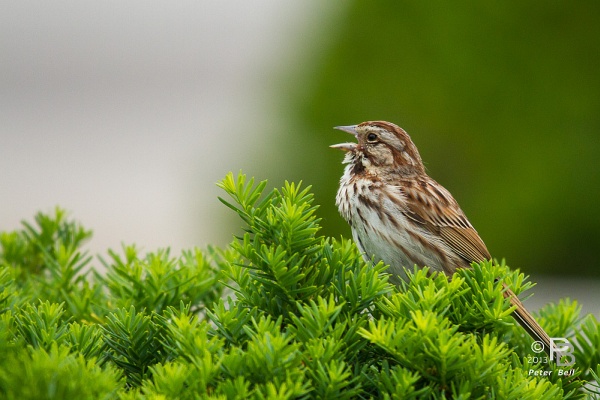
Believe it or not with practice you can recognize individual song sparrows by voice.
I learned this when I read about the pioneering work of Margaret Morse Nice in Columbus, Ohio. In 1928 she began an eight year study of song sparrows at her home along the Olentangy River. Her Studies in the life history of the Song Sparrow changed the course of American ornithology.
Margaret Morse Nice banded the song sparrows and made meticulous observations of their behavior. She listened carefully to their songs and wrote down the variations including the phrases they borrowed from neighbors.
Her research spawned many studies of song development. We now know that: Songbirds learn their songs by listening when they are adolescents, practicing phrases, and eventually mastering their species song. Each bird then improvises to make the song his own. The males work hard to be skilled and unique singers because the females are attracted by the best courtship songs.
I wondered if I could recognize an individual’s song so I started at home.
My backyard is the territory of a male song sparrow whose tune I hear every morning. Eventually I learned his morning song(*). If I could write musical notation I’d put it here.
From my front porch I can hear “my” song sparrow and my neighbor’s front yard sparrow counter-singing to maintain their territories. I know those two don’t sound the same.
I can’t identify more than one tune yet but I can recognize “my” song sparrow in the morning now.
Try it and see.
(photo by Peter Bell)
(*) Dr. Tony Bledsoe says that each song sparrow may have up to five distinct songs. So though I’ve learned the “Good morning” tune I’ve got a lot more learning to do!
I wonder if those were song sparrows I heard back in the day of rotary land line phones, then? For several years, we had birds that could mimic the sound of phones ringing. You could not tell if it was your phone ringing or a bird singing. Now that everyone has a cell phone, these birds no longer make that distinctive ringing sound.
Robin, I’ll bet those were mockingbirds. They mimic cell phones now. 😉
I can’t imagine how difficult it must be to recognize songs of different individuals of the same species. I’m still working on recognizing different species by their songs!
Wow, impressive! I can definitely detect the difference in the calls of the birds between my hometown Buffalo, NY and where I live now in Pittsburgh, PA, but I haven’t gotten to the point of distinguishing local individuals. I’m going to have to up my game!
So many birds have lots of variation in there songs, which confuses me. I try to focus on tone and pitch. This morning I was in Hampton Park and I heard a single note over and over again. My first impression was Blue Jay. Then I heard a rattle and thought Belted Kingfisher. Finally the bird revealed itself to be a Baltimore Oriole.
Kate – You are a wonder. This blog is amazing, and I’ve learned so much. Thank you.
There are times when I’m walking my dog in the early morning and I’ll listen to ONE bird make different sounds. It’s usually on a utility wire that runs over the driveway — it makes about 4 different sounds…..and then I get chased by the mean catbird when it’s nesting in a tree in my front yard.
gindy, maybe you have a mockingbird
I am from Massachusetts and there are a lot of sparrows. I will now be listening very carefully. Although Mockingbirds do make many different sounds I have noticed that the sparrows in my backyard do make different sounds. So interesting.
Thanks for posting this! I’m trying to learn the songs of the birds in my area. My bird app identified two very different simultaneous songs as being song sparrows. I asked Google if it’s possible to identify individual song sparrows by their song, and this post had the answer. So cool.